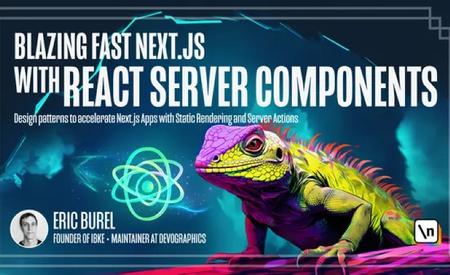English | MP4 | AVC 1920×1080 | AAC 44KHz 2ch | 14 Lessons (1h 24m) | 284 MB
Design patterns to accelerate Next.js Apps with Static Rendering and Server Actions
Learn how to build blazingly fast websites with Next.js. Static rendering is often underrated: it’s very fast, very cheap, but hard to use in advanced scenarios. This course introduces students to personalization with static rendering by using React Server Components, the latest paradigm shift in React. By the end of this course, you’ll have learned advanced Next.js concepts like server actions, static revalidation, client-server relaying, or partial prerendering, and you’ll know when and how to apply different server rendering strategies in large, production-grade Next.js applications. This course mixes recent advanced concepts like Server Action and static rendering in a way that students won’t find in the documentation. Not only will this apply to any content application but also it will apply to dashboards or multi-tenant SaaS.
WHAT YOU WILL LEARN
- Why the performance of a content application matters and how it’s related to different rendering strategies
- How to statically fetch data on a server with React Server Components (RSC)
- How to update static pages with fresh content via data revalidation in Server Actions
- How to perform relaying with SWR, a React Hooks library for data fetching
- How to mix dynamic and static rendering via Partial Prerendering (PPR), an experimental feature introduced in Next.js 14
Table of Contents
1 Newline Commerce demo app
2 Performance matters
3 The Rendering Triforce
4 Rendering in Newline Commerce (demo)
5 Static RSC – the new default
6 Getting data, statically
7 Update data, with Server Actions
8 Static is great, you want static
9 Page-level ‘revalidatePath’
10 Datasource-level ‘revalidateTag’
11 Client-side data fetching recap
12 Relaying with SWR
13 Mix Static and Dynamic Rendering
14 Congratulations!
Resolve the captcha to access the links!
